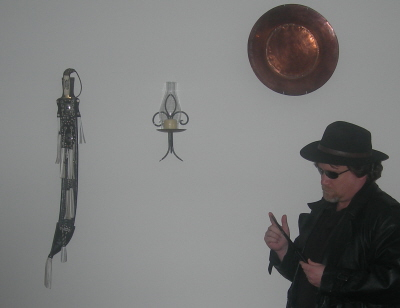|
About This Author
Come closer.
|
Complex Numbers
Complex Numbers
A complex number is expressed in the standard form a + bi, where a and b are real numbers and i is defined by i^2 = -1 (that is, i is the square root of -1). For example, 3 + 2i is a complex number.
The bi term is often referred to as an imaginary number (though this may be misleading, as it is no more "imaginary" than the symbolic abstractions we know as the "real" numbers). Thus, every complex number has a real part, a, and an imaginary part, bi.
Complex numbers are often represented on a graph known as the "complex plane," where the horizontal axis represents the infinity of real numbers, and the vertical axis represents the infinity of imaginary numbers. Thus, each complex number has a unique representation on the complex plane: some closer to real; others, more imaginary. If a = b, the number is equal parts real and imaginary.
Very simple transformations applied to numbers in the complex plane can lead to fractal structures of enormous intricacy and astonishing beauty.
| |
It is a simple fact of life that cats are superior to dogs.
As with most facts, people tend to get it exactly backwards.
https://www.bbc.com/future/article/20191024-why-do-we-think-cats-are-unfriendly
Why do we think cats are unfriendly?
Cats are the only asocial animal we have successfully domesticated. We’re disappointed that we don’t bond with them as easily as dogs. But are we just missing the signs?
Snark aside, I get why people like dogs. I don't dislike them, myself, but for me they're a lot more work. If I had to walk a dog every day, I would quickly grow to resent the time commitment. Also, I don't pick up shit (I use a scoop for the cats' litter boxes).
Dogs seem almost biologically incapable of hiding their inner moods – shuffling, snuffling, tail-wagging clues to contentment, nervousness or sheer, unadorned joy. Despite what the famous painting might want to tell you, dogs would be terrible poker players. We pick up their cues all too easily.
"His tail is thumping. He drew to his inside straight. I fold."
Cats also have sophisticated body language – their moods are signalled through twitching tails, ruffled fur, and the position of ears and whiskers.
A cat's body language is also somewhat idiosyncratic. When Zoe is content, for instance, she tries to curl up on me. When my other cat, Robin, is content, she has a favorite spot that isn't on me. I'm pretty asocial, myself, so Robin's behavior (I guess I should call it "behaviour" since this is a BBC link) suits me just fine, while Zoe's can be annoying.
Robin is mostly only annoying when she's letting me know that her food supply has reached critical levels and I must be reminded of the Covenant.
While we can reasonably be sure of a dog’s bond with us, despite the thousands of years domesticated cats have kept us company, they still suffer something of a bad PR image. The independence that many see as a bonus is seen by others as aloofness or selfishness. Their detractors claim they only really show affection when a food bowl is empty.
Even if that were true - and it may be for some cats - so what? I tend to distrust anything that shows me affection for no apparent reason.
At the very least, the image of the “independent” cat has done it little harm in terms of popularity as a pet. It’s thought there are as many as 10 million domestic cats in the UK alone. Some 25% of households were believed to have at least one cat when a study was undertaken in 2012.
I read somewhere else, I think, that worldwide, there are more pet cats than pet dogs, even though more people live with dogs. I'm guessing the Crazy Cat Lady stereotype skews the numbers there.
The earliest domesticated cats started appearing in Neolithic villages in the Middle East around 10,000 years ago. They didn’t depend on their early human hosts for food – they were encouraged to fetch it themselves, keeping crops and food stores safe from rats and other vermin.
Thus, the advent of Our Feline Overlords would have coincided with the dawn of agriculture and civilization. Dogs are, thus, atavistic.
Our taming of cats has only partly removed them from the wild.
We didn't tame cats. Cats civilized us.
“Because they are so self-determined and can take care of themselves, cats are becoming more and more popular,” Hiestand says. “But whether the lifestyle suits them is another question. Humans are expecting cats to be like us and like dogs. And they aren’t.”
Most of the cat-detractors' screeds that I've seen boil down to: "Well, they're not dogs." Again, this is why I like them.
One vital feature may have allowed dogs to leapfrog cats to our affection. A study from Portsmouth University found that dogs have learned to mimic the expressions of infants, which triggers a desire to nurture in their human owners.
Whereas when I see a baby, my only instinct is to get as far away from the squalling germ-vector as possible. Dogs' tricks would be wasted on me.
“Humans’ expectation bias for the animal impacts their behaviour,” says Vitale. By trying to force cats to behave more like dogs – showering us with attention – we’re trying to push them away from their natural behaviour.
I saw a meme recently that was just a cat with the caption, "The reason cats are so pissy is they're God's perfect killing machines but they only weight 8lbs and we keep picking them up and kissing them."
I don't kiss cats. Fur, you know. Perhaps that is why my cats aren't pissy.
Ultimately, Hiestand says, one thing is key – relaxed cats are more likely to want to make friends. “They want their water and their food and their sleeping arrangements and their litter tray just right, and when they are right, they’re able to start exploring those social bonds.”
Maslow's Hierarchy of Needs  has been largely discredited, I think, but it would be interesting to do one for cats. has been largely discredited, I think, but it would be interesting to do one for cats.
1. Food & water
2. Litter
3. Cardboard boxes
4. Catnip
5. Skritches
So, the next time you come home to find a cat quietly surveying you from the couch, or lazily yawning as they pad their way into the hallway, don’t be disappointed. In their own, quiet way, they’re letting you know it’s good to see you.
Cats have their own language, much like Brits do (that's another dig on the BBC). We get into trouble when we confuse their signals with those of dogs. For instance, a dog rolling on its back is usually a sign of playfulness and submission. For a cat, it signals relaxation and trust - but it's also a fighting pose. This is one reason cats archetypically don't get along with dogs; the dog thinks the cat is being submissive when it really just wants to be left alone.
Still, cats and dogs that are socialized together learn each others' languages. And once you've been around cats long enough, this works for humans, too. |
© Copyright 2025 Robert Waltz (UN: cathartes02 at Writing.Com). All rights reserved.
Robert Waltz has granted InkSpot.Com, its affiliates and its syndicates non-exclusive rights to display this work.
|

